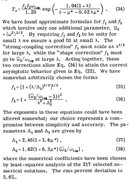Page 1 of 1
Allen dynes formula for Tc is not giving correct lambda from epw calcs
Posted: Wed Dec 11, 2024 8:08 am
by simba2828
Dear EPW Experts,
I am running one anisotropic superconducting calculation where the calculation gives the following output in epw.out file:
Code: Select all
......
a2f file is found and will be used to estimate initial gap
Finish reading a2f file
Electron-phonon coupling strength = 1.6514433
Estimated Allen-Dynes Tc = 3.105056 K for muc = 0.10000
Estimated w_log in Allen-Dynes Tc = 2.153136 meV
Estimated BCS superconducting gap = 0.470929 meV
Estimated Tc from machine learning model = 4.895778 K
.......
With this given lambda (el-ph strength)=1.6514433, w_log= 2.153136 meV and mu*=0.1, I am not getting Tc= 3.105056 K. Could anyone clarify where I am misinterpreting? Is this lambda (1.6514433), given by Migdal-Eliashberg approach, is different from Allen-dynes lambda? Or w_log is something different?
I am attaching a figure where the Allen-Dynes formula for Tc is given.
Thank you for your response.
Sincerely,
Shubham
Re: Allen dynes formula for Tc is not giving correct lambda from epw calcs
Posted: Wed Dec 11, 2024 11:18 am
by simba2828
I noticed that w_log is in meV while it should be in Kelvin. Could anyone tell what is the conversion formula for logarithmic average of omega? Is it E = kB.T?
Also, I noticed that from QE calculations I am getting lambda close to 1 while EPW gives 1.65. Why there is a discrepancy?
Additionally, a2F.dos also print lambda at the end of the file which is 0.77, again a discrepancies. Which one should I consider?
Output of the `lambda` file:
Code: Select all
Electron-phonon coupling constant, lambda
Broadening 0.0200 lambda 0.9669 dos(Ef) 23.4848 omega_ln [K] 52.2538
Broadening 0.0400 lambda 0.8246 dos(Ef) 22.8038 omega_ln [K] 57.1286
Broadening 0.0600 lambda 0.8655 dos(Ef) 20.8352 omega_ln [K] 52.5826
Broadening 0.0800 lambda 0.9878 dos(Ef) 19.8054 omega_ln [K] 46.4001
Broadening 0.1000 lambda 1.0742 dos(Ef) 19.6655 omega_ln [K] 43.4068
Broadening 0.1200 lambda 1.0882 dos(Ef) 20.0924 omega_ln [K] 42.8778
Broadening 0.1400 lambda 1.0565 dos(Ef) 20.8684 omega_ln [K] 43.8291
Broadening 0.1600 lambda 1.0120 dos(Ef) 21.8472 omega_ln [K] 45.6556
Broadening 0.1800 lambda 0.9726 dos(Ef) 22.9001 omega_ln [K] 47.8655
Broadening 0.2000 lambda 0.9425 dos(Ef) 23.9120 omega_ln [K] 50.0714
Re: Allen dynes formula for Tc is not giving correct lambda from epw calcs
Posted: Fri Dec 13, 2024 9:43 pm
by Shashi
Dear Subham,
The w_log unit in EPW is indeed correct and expressed in meV. When converted to Kelvin, w_log is 24.976 K. The w_log expression depends on electron-phonon coupling strength, which differs between EPW and QE in your case giving differences in w_log values. Using your formula, I estimated the Tc to be 3.1038 K, which matches exactly with the Tc printed in EPW output. Please recheck.
Regarding the discrepancy in electron-phonon coupling strength values between QE and EPW, it could likely be attributed to differences between k and q-grid sizes. Typically, QE uses coarser grids, whereas EPW relies on much finer grid sizes. You can also look at the paper by Hitoshi (Phy. Rev. B 110, 064505 (2024)), where he showed for Pb (Table 2) that the electron-phonon coupling strengths differ with grid sizes.
Regards,
Shashi
Re: Allen dynes formula for Tc is not giving correct lambda from epw calcs
Posted: Sat Dec 14, 2024 6:08 pm
by simba2828
Dear Shashi,
Thank you for your reply and the reference. But isn't lambda is very large? In this paper by Allen and Dynes: https://journals.aps.org/prb/pdf/10.1103/PhysRevB.12.905 , it has been explained whenever lambda > 1.5 there is correction factor used in Allen dynes Tc. Is that factor taken into account for the EPW calculations which can explain lambda 1.65?
Thank you again.
Shubham
Re: Allen dynes formula for Tc is not giving correct lambda from epw calcs
Posted: Mon Dec 16, 2024 12:09 am
by Shashi
Dear Subham,
The paper you mentioned discusses the scenarios for asymptotic Tc in the case of lambda < 1 and lambda > 1 in Sec. III. To clarify, there is no additional factor applied in EPW for calculating Allen-Dynes' Tc, and the equation used in EPW is the same as the one you shared. If you wish to obtain more accurate Tc values, I would recommend solving the Eliashberg equations, either using the isotropic or anisotropic formalism in EPW. This approach might be better to compare Tc with your semi-empirical estimation.
Regards,
Shashi
Re: Allen dynes formula for Tc is not giving correct lambda from epw calcs
Posted: Mon Dec 16, 2024 2:07 pm
by simba2828
Thank you Shashi for the clarification.
Re: Allen dynes formula for Tc is not giving correct lambda from epw calcs
Posted: Sat Feb 22, 2025 2:13 am
by Shashi
Hi Subham,
In EPW v5.9 (https://gitlab.com/epw/q-e), we incorporated the Allen-Dynes formula for Tc estimation with strong coupling corrections.
Hope this helps! Let me know if you need any further details.
Best regards,
Shashi
Re: Allen dynes formula for Tc is not giving correct lambda from epw calcs
Posted: Tue Mar 04, 2025 11:41 am
by simba2828
Hi Shashi,
Could you please send me the documentation for EPW, of the corrected formula implemented in EPW? I recently used that formula in one of my paper. A manual in a short page would be enough and helpful.
Thanks,
Shubham
Re: Allen dynes formula for Tc is not giving correct lambda from epw calcs
Posted: Tue Mar 04, 2025 7:02 pm
by Shashi
Hi Subham,
If you check the code in EPW/src/supercond.f90, you’ll find that we have provided references for the Allen-Dynes modified McMillan formula in the strong coupling limit. Specifically, these correspond to Eqs. (34–38) from Allen and Dynes, Phys. Rev. B 12, 3 (1975). For your reference, I am also pasting the formula below.

We haven’t updated the webpage with this information yet, but we will do so soon.
Let me know if you have any questions or need further clarification.
Best regards,
Shashi
